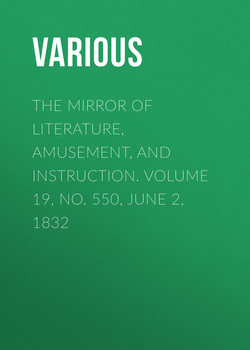Читать книгу The Mirror of Literature, Amusement, and Instruction. Volume 19, No. 550, June 2, 1832 - Various - Страница 1
RARE ARCTIC BIRDS
ОглавлениеTHE WHITE-HORNED OWL
THE COCK OF THE PLAINS
LEGS AND FEET OF THE MOUNTAIN GROUSE.
Few of the results of recent expeditions of discovery have been so interesting to the public as their contributions to zoological history. Many important additions to geographical science have also been made by these journeys into countries hitherto unexplored, or but imperfectly known by Europeans; but the interest is not of that attractive character which is more or less attached to the natural history of these districts. The great delight that we take in the latter species of knowledge is referable to the curiosity we feel respecting the inhabitants of a country after we have once been assured of its existence. Our first inquiries naturally enough relate to the tenants of our own species; we then ask what description of quadrupeds are found over its plains, and how far they enlarge or circumscribe the enjoyments and liberty of sovereign man; the birds that warble in its groves, the insects that flutter in its breeze, the fish that tenant its seas, rivers, and lakes, and the plants that wave in wild luxuriance on its hills and dales; and by comparing all these varieties with the natural characteristics of our own country, and contrasting their differences with others, we are enabled, in some degree, to appreciate, by the linked gradations, the order and harmony that reign throughout nature—the minute beauty of parts which are so essential to the perfection of the grand whole.
The last overland expedition to the Polar sea, under the command of Captain Sir John Franklin, was peculiarly fortunate in the collection of objects of natural history, which indeed were too numerous for the limits of an appendix, such as had appeared with the narratives of previous expeditions. Hence the number of the specimens warranted their publication in a separate form, under the able superintendance of Dr. Richardson, surgeon and naturalist to the expedition, aided by Mr. Swainson. The great expense of the requisite embellishment of the ornithological portion, however, threatened a formidable obstacle to its completeness; but this was met by a liberal grant of one thousand pounds by the British Government, to be applied solely towards the expense of the engravings—the present being the first zoological work ever published with the sterling assistance of His Majesty's Treasury. The first part of this truly great national work appeared some time since, with 28 spirited figures of Mammalia, from drawings by Landseer; the entomological and botanical parts are preparing for publication; and that of The Birds, (to which we are indebted for the annexed Cuts,) has very recently appeared.1
Dr. Richardson, with zealous attachment to his pursuits, passed seven summers and five winters surrounded by the objects he has described with such fidelity. He is, therefore, not a mere book naturalist, but he has studied the habits and zoological details of the living animals; Mr. Swainson having assisted the Doctor in the systematic arrangement and production of the plates. Their descriptions include all the birds hitherto found over an immense expanse of country of the 49th parallel of latitude, and east of the Rocky Mountains, which lie much nearer to the Pacific Coast than to the eastern shore of America: many of these birds being, for the first time, made known to ornithologists. We have selected two of the most singular in their conformation: one from the Owls, which are numerous and beautiful; and the other from the Grouse, of which ten fine species are described.2
1
Fauna Boreali-Americana, or the Zoology of the Northern Parts of British America. Part II., containing the Birds. By W. Swainson, Esq, F.R.S. and John Richardson, Esq., M.D. F.R.S., &c. 4to. 253 pages, with 50 coloured plates, and 40 illustrative wood cuts. London, Murray, 1832.
2
Flocks of Ptarmigans, when pursued by the jar-falcon, endeavour to save themselves by plunging instantly into the loose snow, and making their way beneath it to a considerable distance.
